| |
May 2014
In this issue:
|
 Modiano Modiano
|

1. Comings and goings
Professor Eytan Modiano is the new department associate head, taking up the reins from Professor Karen Willcox who has stepped down from that position. Eytan's office is in AeroAstro HQ, 33-207. Melanie Burliss will support Karen who has moved to 33-412. Headquarters staff will support Eytan.
Professor Dave Darmofal has returned from sabbatical and is situated in 31-268. Professors Emilio Frazzoli, John Hansman, and Brian Williams continue on sabbatical for the remainder of the academic year.
For the spring semester, Professors Kerri Cahoy and Zolti Spakovszky will be on parental leave.
Welcome to new postdocs Benjamin Peherstorfer, with Professor Willcox; and Brian Yutko and Florian Allroggen, with Professor Barrett.
Professors Larry Young and Manuel Martínez Sánchez officially retired in January. Both will continue to be involved in the department and may still be found in their current offices.
Missy Cummings is now an associate professor at Duke University. She will hold a visiting appointment at MIT until her current students have graduated. |
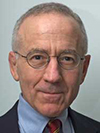 Greitzer Greitzer

Harris
 Roy Roy
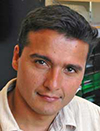 Lozano Lozano
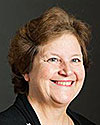 Dowling Dowling

Wolfe
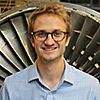 Staples Staples
|
2. Honors and awards
The American Institute of Aeronautics and Astronautics has announced that Professor Ed Greitzer has been named one of three individuals to receive the distinction of AIAA Honorary Fellow, the highest distinction conferred by the organization. AIAA Honorary Fellowship "is granted to preeminent individuals who have long and highly contributory careers in aerospace, and who embody the highest possible standards in aeronautics and astronautics." The AIAA also honored Professors Nick Roy and Paulo Lozano, naming them AIAA Associate Fellows. Associate Fellows must have at least 12 years professional experience, and be recommended by a minimum of three current Associate Fellows.
MIT has named Professor Wes Harris a recipient of the Institute's 2014 Martin Luther King, Jr. Lifetime Achievement Award. This special award, created for the MLK Breakfast Celebration's 40th anniversary, "recognizes individuals and groups affiliated with MIT who have displayed a commitment of service to others and dedication to positive social changes in their community."
Dame Ann Dowling, U. Cambridge Dept. of Engineering Head and former AeroAstro Hunsaker Professor was confirmed as the candidate for first woman president of the Royal Academy of Engineering, a position she will assume this September. Dame Ann started her career as a mathematician. She now leads research on efficient, low-emission combustion for aero and industrial gas turbines and low noise vehicles, particularly aircraft and cars.
Grad students Philip Wolfe and Mark Staples, both research assistants in the Laboratory for Aviation and the Environment, have been named DOT FAA Centers of Excellence Student of the Year and PARTNER FAA Center of Excellence Student of the Year, respectively.
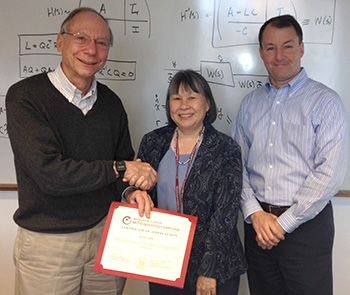
AeroAstro Fiscal Officer Ping Lee was recognized by the Gordon Engineering Leadership Program "for six years of outstanding logistical support to the Gordon-MIT ELP." Pictured with Ping are (left) GELP Director Joel Schindall and Executive Director Leo McGonagle.
The FAA and USDOT have chosen recent Course 16 MS recipient Kyle Smith as winner of their annual RAISE (Recognizing Aviation and Aerospace Innovation in Science and Engineering) Award for his proposal for an aviation collision avoidance system. Extensive simulation studies demonstrated the success of Kyle's approach, and a successful flight test was conducted at the FAA's Hughes Technical Center in August. Kyle is an Air Force Academy graduate and lieutenant in the USAF. While at MIT, he was a Lincoln Lab Fellow. Professor Jon How was his advisor.
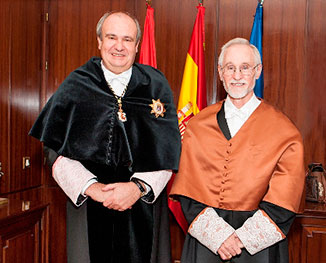
Professor Manuel Martínez Sánchez (right), pictured with Universidad Politécnica de Madrid Rector Carlos Conde, has been presented with a UPM Doctor Honoris Causa. The award cited him for his exceptional teaching and his research "beyond our borders."
|
|

3. AeroAstro to celebrate 100th anniversary
The first aeronautics class at MIT, titled simply "Aeronautics," appeared in the 1913-14 course catalogue. And, in 1914, the MIT Corporation approved a schedule of studies for an SM in Aeronautical Engineering.
In celebration of 100 years of MIT aerospace, we're planning a number of special events commencing with an April 23 10 a.m. to 4 p.m. department-wide open house, to be held in conjunction with the Cambridge Science Festival. There will be lab tours, demonstrations, interactive projects, and lots more. Other AeroAstro 100 events proposed for the coming year are a mini-display at the MIT Museum, a brown bag lunch series, a special edition of our annual Women in Aerospace symposium, and a two-day symposium. More information coming soon. Those interested in volunteering to assist during the open house, especially helping to direct visitors and staffing hands-on activities, are invited to email Bill Litant, AeroAstro communications director, wlitant@mit.edu

Military aviation students learn to rig a biplane at MIT during World War One.
|
|

4. Unmanned systems test site coming to Mass.
A new unmanned aircraft test site in Massachusetts will offer MIT classes and research groups government-sanctioned airspace only an hour and a half from campus. The facility, located at Joint Base Cape Cod, will be a boon for Institute researchers developing unmanned aerial vehicles and their associated systems, says AeroAstro Professor Jonathan How, the test site’s academic liaison. FAA restrictions have made it difficult for researchers to test unmanned aircraft systems in realistic environments, says How, who directs the Aerospace Controls Laboratory. How is a member of the Northeast UAS Airspace Integration Alliance, a consortium of more than 40 public and private organizations from Massachusetts and New York that proposed the test site to the FAA. -more- |
|

5. SMART's cart
In concert with the National University of Singapore, the Singapore-MIT Alliance for Research and Technology (SMART) has built the first Singapore prototype autonomous car for operation on public roads. Project lead investigator AeroAstro Professor Emilio Frazzoli says: “SCOT (Shared Computer Operated Transport) is a testimony of the researchers and students’ talent, innovation and dedication considering that we converted the electric car into a driverless car in just six months at no more than S$30,000 (about US$23,500) for the sensors
and onboard computer.” Unlike some other driverless cars that are retrofitted with 3-D laser sensors, SCOT relies on low-cost off-the-shelf LIDAR sensors, which enable the car to drive autonomously, independent of GPS. This allows it to drive in tunnels and locations where GPS signals are unavailable.
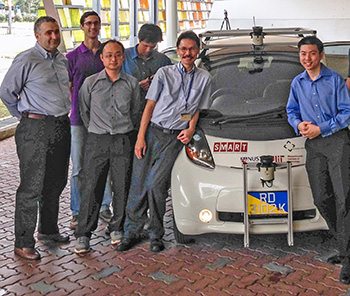
Professor Emilio Frazzoli (left) is PI for the SCOT autonomous automobile project.
|
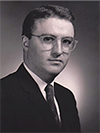 Markey Markey
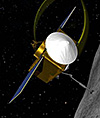
OSIRIS-REx
|

6. Newsbriefs
The AeroAstro community was saddened to learn of Professor emeritus Win Markey's death on January 4, 2014. Professor Markey had retired in 2000, continuing to teach until 2003. He received his BS at MIT in 1951 and then became a candidate for a doctoral degree in intstrumentation. In 1957, he joined the AeroAstro faculty. Interestingly, three others who became AeroAstro assistant professors at the same time were Wallace Vander Velde, Judson Baron, and John Dugundji. Professor Markey's professional interests were chiefly in weapons system design and he taught several fire control courses restricted to military students. He also was known for expertise in interplanetry navigation. Thanks to Professor Dugundji for this biographical information.
Doctor Becky Masterson, research engineer in the Space Systems Lab, has created a Twitter feed for the lab's REXIS instrument: @REXIS_MIT. REXIS is an imaging device designed to fly aboard a 2016 NASA mission to collect a piece of an asteroid and return it to earth. For more on REXIS, visit http://web.mit.edu/newsoffice/2011/asteroid-mission-0726.html
Also in the Space Systems Lab: On January 24 the SPHERES team worked from the SSL with astronauts Richard A Mastracchio (NASA) and Koichi Wakata (JAXA) aboard the International Space Station running the experiment VERTIGO Science Session #2. VERTIGO is a stereo camera system that allows the self-propelled SPHERES satellites to navigate in station using vision processing. In this experiment, the satellite with the cameras moved around the other satellite while "seeing" it and creating a 3D digital map.
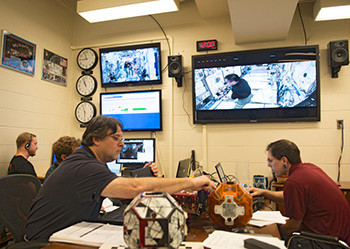
In the Space Systems Lab (from left) postdoc Brent Tweddle (PhD '13), grad student Tim Setterfield (partially obscured), Joe Zapetis (Aurora Flight Sciences), and SSL associate director Alvar Saenz-Otero monitor the SPHERES test being conducted on the International Space Station.
|
 
|

Follow AeroAstro
Don't wait for your enews and emails — keep up with AeroAstro news as it happens — follow the department on Twitter and Facebook. |
|
If you know of events, honors, activities, or other information you'd like to see in the next issue of AeroAstro enews, please send to wlitant@mit.edu. |
|
|

 Modiano
Modiano Greitzer
Greitzer
 Roy
Roy Lozano
Lozano Dowling
Dowling
 Staples
Staples



 Markey
Markey
